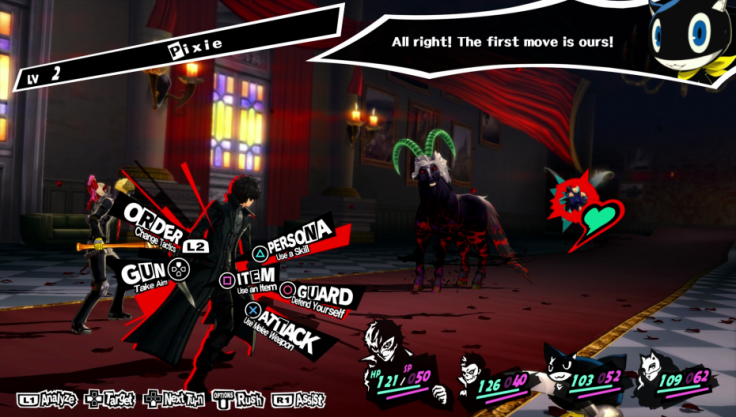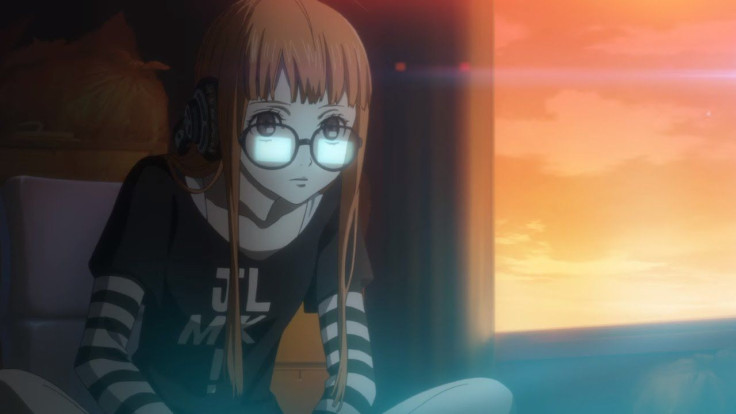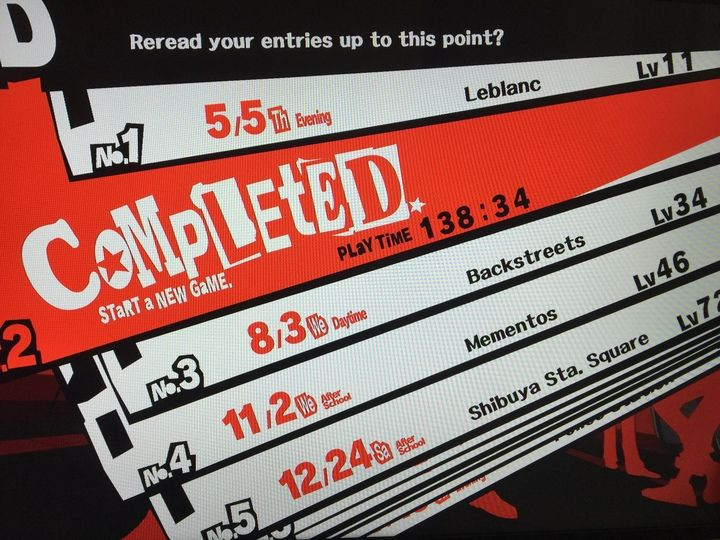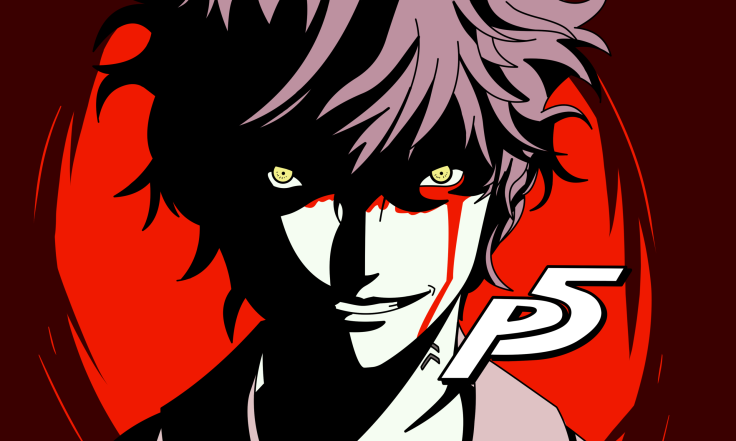As someone who came to gaming in the SNES / PS1 era, playing through Persona 5 (repeatedly) made me reflect on the kind of “future games” I’d daydreamed about as a kid. Those imaginings had very little to do with impeccably polished hair physics or trigger-happy action combat; basically, I wanted the eight-disc expanded edition of Final Fantasy VII, or Chrono Trigger with more time periods to visit. I wanted an expanded cast of characters. I wanted a longer story. In other words, I wanted more of what I already loved.
If my own past imaginings come across as technically unambitious, be assured that the latest installment in the Persona series is anything but. Persona 5 brings the franchise’s hallmarks -- deep turn-based combat, Pokémon-esque monster crafting and the soap opera of social-sim elements -- into the modern console era with impeccable panache. While it’s not without flaw, the overall experience of the game is superlative. These issues seem like minor quibbles.
The latest installment in the Persona series sees you take on the role of leader of the Phantom Thieves, a group of teenage bandits who “steal hearts” by infiltrating an alternate reality known as the Metaverse in order to force nefarious adults to publicly confess their crimes. As the success of the Phantom Thieves grows, their targets become steadily more high-profile. All of these baddies have their own themed dungeon, or Palace, with unique designs and puzzle elements.
These Palaces are one of the game’s strongest assets, with consistently surprising attention to detail and irreverent design making them far more engaging than the procedurally generated dungeons of previous Persona entries. While I won’t spoil them here, each one is far more clever than the typical water temple / lava cave / sewer maze RPG fare. (While there is a castle, it’s decorated with statues of shapely butts; Persona has never shied away from being weird.) The Palaces consistently ramp up the challenge, but never feel grindy. While the game incentivizes you to beat the palaces in as few in-game days as possible, as it frees up more time to spend on other activities, it’s entirely possible to break up dungeon runs into smaller chunks. There’s no auto-save feature, but there are enough Safe Room save points scattered around to keep you from losing loads of progress if you get one-shotted by a group of enemies. (And believe me, it will happen.)

P5’s nimble combat system is a key reason its lengthy dungeons -- some of which can take eight to 10 hours to complete -- never seem to drag. Turn-based combat has been been about as fashionable as corduroy in role-playing games of late, with titles like Final Fantasy XV, Tales of Berseria, Nier: Automata and Breath of the Wild each making their own compelling case for action-driven, on-the-fly fighting. P5, on the other hand, demonstrates turn-based battles can be just as quick and exciting, while offering a bit more strategic and tactical nuance. If you’re feeling outmatched or limping to the nearest Safe Room, you can still “defeat” an enemy by negotiating for items, cash, or allowing them to join your roster of personae, allowing you to use that creature’s skills in battle.
Spelunking around Palaces and laying waste to monster hordes with your increasingly powerful assortment of personae is only one half of the game. By day, you’re just an ordinary transfer student (albeit one with a shady past), negotiating high school life at Tokyo’s Shujin Academy and making relationships with your classmates, foster family and local weirdos. These relationships are known as Confidant Links (Social Links in previous games), and allow your protagonist to create stronger personae to use in battle. While the social and combat aspects have always been closely intertwined in the Persona series, the perks this time around are better than ever. Advancing Confidants will unlock abilities like switching party members mid-combat, earning more money and experience in battles, and new item and weapon crafting abilities.
One of the undeniable pleasures of the slice-of-life half of Persona 5 is exploring the game’s recreation of Tokyo, rendered in dizzying, intricate detail. If you’ve never been to Japan and desperately want to go (like me), Persona 5 might help scratch that itch a little. (There’s a great piece on Kotaku from a while back comparing real-world locations to P5’s in-game Tokyo, and it’s stunning just how close to life the game's locations are.) So much has already been said about Persona 5’s stylish presentation that it feels unnecessary at this point to repeat it. The game does, indeed, look great, whether we’re talking 3D character models, anime cutscenes or environments.
READ: 'Persona 5' First Look: The Phantom Thieves Will Steal Your Heart, Then Steal Your Life
All that said, a great combat system and eye-grabbing aesthetics aren’t worth a whole lot without a solid story and endearing characters. Fortunately, P5 has both. What begins as a schoolyard beef slowly evolves into a conflict of national, even global consequence, in a way that (mostly) makes sense and plays out naturally. While some of the characters draw quite generously from anime tropes (or even previous Persona games), there’s some unique new personalities in the crowd. The socially anxious computer geek Futaba and the prim, broke-as-a-joke painter Yusuke were two particular standouts for me. For those familiar with the series, the game’s vibe falls somewhere between the detached individuals of P3 and the goofball superfriends of P4.

One of the things that makes the P5 cast truly stand out from their predecessors, though, is the way they grow and evolve over the course of the game, and the shades of gray present within each character. Yes, each of your party members goes through that “I am thou, thou art I” moment of recognizing the darker aspects of themselves as in previous Persona games, but that doesn’t make them instantly, irreversibly heroic. The Phantom Thieves make some huge mistakes in their pursuit of fame and approval, and it’s not always clear to them (or us) that they really are the good guys.
Without spoiling anything, the story offers up some pretty stunning twists and turns over the course of the Thieves’ rise to fame/infamy, though overall the drama never quite reached the high notes struck by some of the endgame moments of Persona 4. Certain events in P5 I saw coming a mile off, and the fate of the game’s most compelling antagonist isn’t resolved in a particularly satisfying way. That’s not to say the story is inadequate or in any way half-baked; it’s fantastic, and I couldn’t wait to see what happened next. But it never quite ripped the rug out from under me like P4.
If this and the many other glowing reviews for Persona 5 haven’t yet convinced you it’s worth the price of admission, consider the value you’ll be getting for your entertainment dollar. Here’s how long it took me to beat P5:

No Photoshop witchery here - that's 138 hours. Which may explain why I’m reviewing it a month after it came out. To clarify: I’m not a newcomer to the series, nor a slavish completionist. But I’m thorough. I maxed all but four of 21 Confidants and four out of five Social Stats in my playthrough. I didn’t grind at all for levels, equipment or OP super-fancy personae. While this time is somewhat inflated due to writing guides or doing other iDigi business that required leaving the game running in the background, it’s very reasonable to expect to get 100+ hours out of P5, without including grinding or a New Game + playthrough. And that’s 100+ polished, cohesive and complete hours of gameplay -- you don’t need a Day One patch or DLC to actually get the whole story here.
Persona 5 isn’t just the best game I’ve played this year, it’s the best game I’ve played in years. And I can’t wait to do it all again.
- Gripping, twisty-turny story
- Collect all the waifus!
- Rapid-fire turn-based combat
- Infectious soundtrack
- Literally everything
- A cat making you go to bed when you're not tired
- Say goodbye to your actual life



















